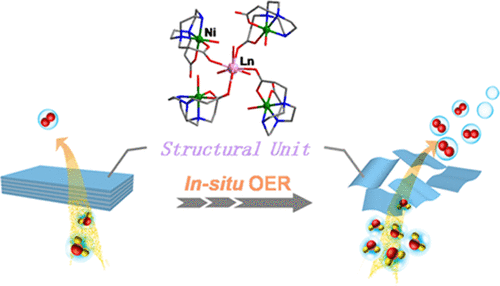当前位置:
X-MOL 学术
›
ACS Sustain. Chem. Eng.
›
论文详情
Our official English website, www.x-mol.net, welcomes your
feedback! (Note: you will need to create a separate account there.)
Ion-Induced Delamination of Layered Bulk Metal–Organic Frameworks into Ultrathin Nanosheets for Boosting the Oxygen Evolution Reaction
ACS Sustainable Chemistry & Engineering ( IF 7.1 ) Pub Date : 2020-06-29 , DOI: 10.1021/acssuschemeng.0c03376 Jin Huang 1 , Ji-Qing Wu 1 , Bing Shao 1 , Bi-Liu Lan 1 , Fu-Jie Yang 2 , Yao Sun 1 , Xiao-Qiong Tan 1 , Chun-Ting He 3 , Zhong Zhang 1
ACS Sustainable Chemistry & Engineering ( IF 7.1 ) Pub Date : 2020-06-29 , DOI: 10.1021/acssuschemeng.0c03376 Jin Huang 1 , Ji-Qing Wu 1 , Bing Shao 1 , Bi-Liu Lan 1 , Fu-Jie Yang 2 , Yao Sun 1 , Xiao-Qiong Tan 1 , Chun-Ting He 3 , Zhong Zhang 1
Affiliation

|
Creating ordered two-dimensional (2D) metal–organic framework (MOF) nanomaterials is conducive to understanding the structure–property relationship for rationally designing high-efficiency electrocatalysts. However, the controllable synthesis of ultrathin MOF nanosheets with predesigned structures and anticipative properties is still a great challenge. Here, we reported an electrolyte-assisted electrochemical approach to in situ exfoliate the intrinsic 2D MOF crystals with the Ni4Ln cluster as a secondary building unit (SBU) into ultrathin metal–organic nanosheets. Notably, the electric current density of the oxygen evolution reaction rapidly increases from 9.4 to 31.0 mA cm–2 at 1.8 V and the Tafel slope reduces from 150 to 87 mV dec–1, originating from electrochemically delaminating the thick 2D MOF precursors into ultrathin (∼4 nm) nanosheets to expose more catalytic active sites. Furthermore, the electrocatalytic oxygen evolution reaction (OER) activity of these 2D heterometallic MOF nanosheets can be effectively manipulated through precisely altering the lanthanide component of the Ni4Ln SBU in the layered MOFs. Density functional theory calculations reveal that the lanthanide ion of the SBU affects the adsorption and desorption capacity of active nickel centers to OER-relevant species, leading to the difference of the catalytic activity.
中文翻译:

离子诱导的层状大块金属有机骨架分层为超薄纳米片,以促进氧气释放反应
创建有序的二维(2D)金属-有机骨架(MOF)纳米材料有助于理解结构-性质之间的关系,从而合理地设计高效电催化剂。然而,具有预先设计的结构和预期性质的超薄MOF纳米片的可控合成仍然是巨大的挑战。在这里,我们报道了一种电解质辅助电化学方法,将以Ni 4 Ln团簇为二级构建单元(SBU)的固有二维MOF晶体剥落成超薄金属有机纳米片。值得注意的是,氧气释放反应的电流密度在1.8 V时从9.4迅速增加到31.0 mA cm –2,Tafel斜率从dec –1减小到150 mV至87 mV。这是由于将厚的2D MOF前体进行电化学分层而形成的超薄(〜4 nm)纳米片,从而暴露出更多的催化活性位。此外,通过精确地改变层状MOF中Ni 4 Ln SBU的镧系元素,可以有效地控制这些二维异金属MOF纳米片的电催化放氧反应(OER)活性。密度泛函理论计算表明,SBU的镧系离子会影响活性镍中心对OER相关物种的吸附和解吸能力,从而导致催化活性的差异。
更新日期:2020-07-20
中文翻译:

离子诱导的层状大块金属有机骨架分层为超薄纳米片,以促进氧气释放反应
创建有序的二维(2D)金属-有机骨架(MOF)纳米材料有助于理解结构-性质之间的关系,从而合理地设计高效电催化剂。然而,具有预先设计的结构和预期性质的超薄MOF纳米片的可控合成仍然是巨大的挑战。在这里,我们报道了一种电解质辅助电化学方法,将以Ni 4 Ln团簇为二级构建单元(SBU)的固有二维MOF晶体剥落成超薄金属有机纳米片。值得注意的是,氧气释放反应的电流密度在1.8 V时从9.4迅速增加到31.0 mA cm –2,Tafel斜率从dec –1减小到150 mV至87 mV。这是由于将厚的2D MOF前体进行电化学分层而形成的超薄(〜4 nm)纳米片,从而暴露出更多的催化活性位。此外,通过精确地改变层状MOF中Ni 4 Ln SBU的镧系元素,可以有效地控制这些二维异金属MOF纳米片的电催化放氧反应(OER)活性。密度泛函理论计算表明,SBU的镧系离子会影响活性镍中心对OER相关物种的吸附和解吸能力,从而导致催化活性的差异。











































 京公网安备 11010802027423号
京公网安备 11010802027423号